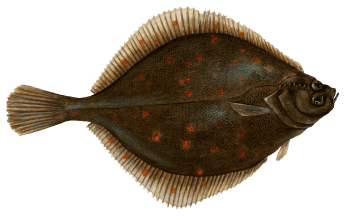Butter Sole

Species Details
Isopsetta Isolepis
Pleuronectidae
Pleuronectiformes
shallow waters, silty bottom
lbs.
8" - 22"
Butter Sole (Isopsetta isolepsis) Fish Description
A Butter Sole is an edible flatfish that often swims in shallow waters. It has an oval-shaped body, and both its eyes are on the right side, which is small and positioned close to each other. Its body has different colors on each side – the upper with light to dark grayish brown and some yellow or green markings, while its underside is just white. Its anal and dorsal fins have bright yellow edges, while its caudal fin or tail forms a broad ‘V’ shape. It has a small mouth with blunt teeth.
The Butter Sole’s body is covered with scales that are rough on the upper side.
Butter Soles are often mistaken as the Rock Sole, but the latter has a shorter accessory dorsal branch while Butter Soles are longer and even extending past the gill cover.
Diet & Size
Butter Soles feed on young herring and benthic organisms like sand dollars, chaetopod marine worms, crabs, and shrimps. The average length of a Butter Sole is 8 inches and can grow up to 22 inches.
Butter Sole Interesting Facts
- Butter Soles can live up to 11 years.
- A Butter Sole’s meat is very tasty and can be cooked in many ways.
- They also serve as mink food.
- Adult Butter Soles migrate from the North to the South during the spawning season.
- A Butter Sole is called ‘right-handed’ flounder because both its eyes are on the right side.
Fishing Techniques: How to Catch a Butter Sole
There isn’t much information on how to catch Butter Sole, specifically. But catching one would be like catching soles, flounders, or any flatfishes in shallow waters.
You can try fly fishing by the beach or nearby fishing ledges, especially when the current flows from shallow to deep. You can use light tackles and quarter-ounce jigs and cast your lines parallel to the ledge.
You can also try drift fishing and trolling since it doesn’t bit into lures right away. However, it follows it and often settles under the boat. Doing this might be tricky and could take time. But once you catch one, you'll certainly catch more in that same area.
But if you’re adventurous enough and would like to try a different technique, you can try flounder gigging. Since Butter Soles are the same as flounders in the sense that they stay in silty bottoms, gigging at night, especially during spring and summer, might be something you want to try.
However, Butter Soles are not much of a gamefish. Maybe this is why there’s no record for Butter Sole in the International Game Fish Association. Most of the time, they are caught by recreational anglers, especially those who do catch-and-cook, but mostly by commercial fishers since its meat is really good for cooking.
Habitat and Distribution
Anglers found Butter Soles within the range of the southern Bering Sea to the Amchitka Islands (also called the Aleutian Islands) in southern California.
They frequent the shallow waters, especially in silty, soft bottom. However, they migrate to the deep during the winter. They swim within the depths of 65 to 1,394 feet and waters with a temperature between 40 to 51 degrees Fahrenheit.







